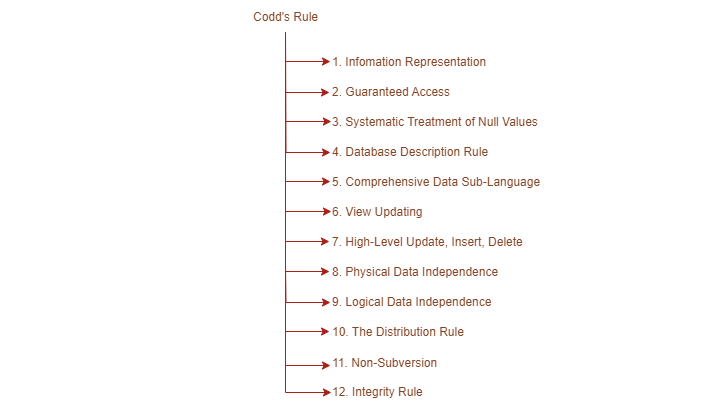
 Data Structure
Data Structure Networking
Networking RDBMS
RDBMS Operating System
Operating System Java
Java MS Excel
MS Excel iOS
iOS HTML
HTML CSS
CSS Android
Android Python
Python C Programming
C Programming C++
C++ C#
C# MongoDB
MongoDB MySQL
MySQL Javascript
Javascript PHP
PHP
- Selected Reading
- UPSC IAS Exams Notes
- Developer's Best Practices
- Questions and Answers
- Effective Resume Writing
- HR Interview Questions
- Computer Glossary
- Who is Who
OLAP Guidelines (Codd_s Rule)
OLAP (Online Analytical Processing) is data processing technique. It is used to query and analyze data. It analyze data in real time from multiple sources.
In 1993, EF Codd introduced 12 rules for the relational database model for OLAP systems. These rules are known as "Codd's rules". These rules serve as a guideline for the design and development of OLAP systems. In this article, we will explore these 12 rules developed by Codd.
Codd's rules
These are 12 rules for OLAP systems, as proposed by E.F. Codd ?

Multidimensional Conceptual View
OLAP system should provide multidimensional conceptual view of the data. This view should be based on the needs of the user and not on the physical data storage.
Transparency
System should be transparent to the user. But data abstraction property should be preserved.
Accessibility
System should provide easy access to the data. Users can access the data through user-friendly interface.
Consistent Reporting Performance
System should provide consistent reporting performance regardless of the complexity of the query or the amount of data being analyzed.
Client-Server Architecture
System should be based on client-server architecture. It has multiple users to access the system at the same time.
Generic Dimensionality
The system should support generic dimensionality. System can handle any number of dimensions and any type of data.
Dynamic Sparse Matrix Handling
System should be able to handle dynamic sparse matrices. System can handle data that is not regularly populated.
Multi-User Support
System should support multi-user access. Multiple users can access and analyze data at the same time.
Unrestricted Cross-Dimensional Operations
System should allow unrestricted cross-dimensional operations. System should allow users to analyze data from different dimensions without restrictions.
Intuitive Data Manipulation
System should provide intuitive data manipulation tools. Users can manipulate and analyze data in a user-friendly manner.
Flexible Reporting
System should provide flexible reporting capabilities. Users can generate reports in various formats and with different levels of detail.
Unlimited Dimensions and Aggregation Levels
System should support unlimited dimensions and aggregation levels. System should can handle any number of dimensions and any level of aggregation.
An OLAP system should also have some other features
It should have good tools for managing databases. This helps people who manage databases to control many different businesses at once.
People should be able to "drill down" into the details.. They should be able to see detailed level data.
System should be able to update the data gradually. System can add new data to the database without having to reload everything.
System can use Structured Query Language (SQL). This helps the system work well with other programs that a business might use.
Conclusion
These rules ensure the needs of users. It provides reliable and efficient data analysis. Not all OLAP systems may be able to meet all of these guidelines. Some may prioritize certain rules over others based on their specific use cases.

